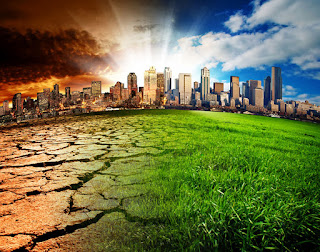Global warming and climate change are buzz words today. Despite what President Trump says, it is a present reality. Temperatures today are 0.74 °C (1.33 °F) higher than 150 years ago. Many scientists say that in the next 100–200 years, temperatures might be up to 6 °C (11 °F) higher than they were before the effects of global warming were discovered.
 |
| (shutterstock) |
Ocean acidification threatens damage to coral reefs, fisheries, protected species, and other natural resources of value to society. Greenhouse gases absorb and emit some of the outgoing energy radiated from Earth’s surface, causing that heat to be retained in the lower atmosphere.
The challenge is to try to limit the extent and mitigate the effects.
he First Great Walking
As I work through the book A Brief History of the Future by Charles Joynson, he decided that by 2095 Greenland lost the last of its glaciers and ice sheets and nearly 40% of Antarctica’s ice sheets were lost. This caused a 3 metre rise in sea levels, coastal cities had to be abandoned and floating neighbourhoods were built. Cyclones and hurricanes caused much damage and mountainous regions became too dry to farm.
All this led to the First Great Walking, when 500 million people took to the roads, trying to find somewhere else to live. Flooded island nations had to be rescued and taken in fleets of ships to volunteer adoptee nations. When we consider the challenges of refugees and asylum seekers today, can you imagine 500 million people moving?
He has the idea that they even considered damning the Mediterranean to keep sea levels static but realised it would become hypersalinated and devoid of life.
2095 is only 76 years away. Too long for my lifetime, but maybe some of my children will see it and certainly my grandchildren. Even if Joynson’s predictions are too extreme, how far will climate change go? How much can we correct it and how much will we have to learn to live with it?
Fiction Warning
On the fiction side, there is a great novel Flood by Stephen Baxter (who later co-wrote The Long Earth with Terry Pratchett) about the world being inundated by unstoppable rising water. This time it’s not climate change, but water locked in the earth.
Next year. Sea levels begin to rise. The change is far more rapid than any climate change predictions; metres a year. Within two years London, only 15 metres above the sea, is drowned. New York follows, the Pope gives his last address from the Vatican, Mecca disappears beneath the waves.
Where is all the water coming from? Scientists estimate that the earth was formed with seas 30 times in volume their current levels. Most of that water was burnt off by the sun but some was locked in the earth’s mantle. For the tip of Everest to disappear beneath the waters would require the seas to triple their volume. That amount of water is still much less than 1% of the earth’s volume. And somehow it is being released. The world is drowning. The biblical flood has returned.
And the rate of increase is building all the time. Mankind is on the run, heading for high ground. Nuclear submarines prowl through clouds of corpses rising from drowned cities, populations are decimated and finally the dreadful truth is known. Before 50 years have passed there will be nowhere left to run.
FLOOD tells the story of mankind’s final years on earth. The stories of a small group of people caught up in the struggle to survive are woven into a tale of unimaginable global disaster. And the hope offered for a unlucky few by a second great ark…
Ann Marie Thomas is the author of four medieval history books, a surprisingly cheerful poetry collection about her 2010 stroke, and the science fiction series Flight of the Kestrel. Book one, Intruders, and book two Alien Secrets, are out now. Follow her at http://eepurl.com/bbOsyz